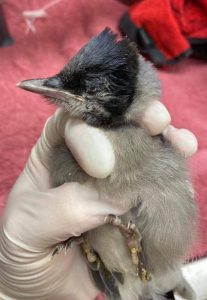
7-31-21 Daily Herald – A sick blue jay was admitted to the Willowbrook Wildlife Center in Glen Ellyn with crusted, swollen eyes, the symptoms of a mysterious illness that has killed songbirds in mid-Atlantic and Midwestern states. courtesy of the Willowbrook Wildlife Center.
The young bird, a blue jay about a month old, couldn’t open its eyes, both swollen and crusted shut.
Willowbrook Wildlife Center in Glen Ellyn took in the sick fledgling on Sunday, the first seen with the symptoms of a mystery songbird illness reported in about a dozen mid-Atlantic and Midwestern states.
“This was truly the first case where we saw this animal, and we were like, this doesn’t look good,” said Dr. Sarah Reich, the center’s head veterinarian and rehabilitation and research manager.
This week, Oaken Acres Wildlife Center in Sycamore also admitted a blue jay in similar condition, Reich said. Both birds came from Cook County.
The Illinois Department of Natural Resources has not received any other reports of fledglings showing the signs of illness observed in other states, an agency spokesman said.
“We are highly concerned that this could be the start of this disease in Illinois or at least of seeing the disease,” Reich said.
Researchers haven’t been able to explain how or why birds are getting sick and dying, though they’ve ruled out some theories. The ailment has afflicted mostly blue jays, common grackles, European starlings and American robins, but it’s turned up in other species of songbirds.
“We’ve known of this potential disease for six weeks plus, and despite some of the most renowned labs across the country having a part in the testing, they haven’t really come up with anything definitive,” Reich said.
Wildlife managers in Washington, D.C., Maryland, Virginia, West Virginia and Kentucky began receiving reports of birds with eye swelling and crusty discharge, as well as neurological issues, in May, the U.S. Geological Survey said. More recently, Delaware, New Jersey, Pennsylvania, Ohio and Indiana have logged additional reports.
The blue jay brought to Willowbrook had to be euthanized, Reich said, and the other bird at Oaken died within 24 hours.
Willowbrook sent the remains of both birds to the Indiana Animal Disease Diagnostic Laboratory, one of the testing facilities trying to identify the cause of the songbird deaths.
As expected, an initial necropsy didn’t produce any significant findings, but a battery of more extensive tests on tissue samples could take weeks or months, Reich said.
“It’s hard sometimes to save wildlife even when we do know what’s going on,” she said. “But it’s extremely challenging when we don’t have an idea of is this a viral infection? A bacterial infection? Fungal? Is it toxic? Is it from human intervention?”
Investigating a cause
In Indiana, reports of sick and dying birds have spanned 69 counties. Birds so far have tested negative for avian influenza, West Nile virus, salmonella, chlamydia, herpesviruses and other possible culprits. Researchers also have considered types of parasites.
“Typically, these things take a long time to actually define and determine what the cause is,” Indiana state ornithologist Allisyn Gillet said. “And the reason why is because when you think about a wild animal, there are so many different things that they deal with in the wild. There are so many threats that they encounter that could lead to symptoms like this.”
Indiana wildlife officials have encouraged Hoosiers to remove backyard feeders statewide to keep birds from congregating because experts don’t yet know if the illness could be contagious.
Illinois officials, however, are not recommending that people take down feeders.
“We consulted with federal colleagues this week. Most credible reports nationwide have all but stopped,” an IDNR spokesman said Thursday. “Folks should continue to clean their birdbaths and feeders regularly as a matter of course.”
Indiana currently gets about 40 legitimate reports a week, Gillet said.
“I don’t think it’s decreasing, per se, but it’s leveling off, so it’s not out of control,” she said. “It’s not getting worse. It’s not getting any better.”
Juvenile birds seem to be the hardest hit.
“When tracking it, we’ve noticed that it mainly has occurred in certain hot spots, certain areas, specifically to suburban and urban areas,” Gillet said. “That could be, again, perhaps biased by people who are really interested in birds. They’re the ones that are reporting them more.”
Gillet said she isn’t worried about a population-level effect.
“With West Nile virus, birds were falling from trees,” she said.
‘It doesn’t line up’
The blue jays brought to Willowbrook and Oaken Acres were “very quiet” for their species, Reich said.
“I wouldn’t necessarily say that they had overt neurological signs, but their quietness and that change in mentation can be considered some sort of neurological disease as well,” she said.
Reports indicate that sick birds don’t respond to treatments.
“Since we knew that the prognosis for this bird was already likely fatal, we elected to euthanize due to that level of debilitation,” Reich said.
She’s hoping that Willowbrook won’t see any more cases moving toward the end of “baby season.” Blue jays have a bit more prolonged nesting season, she said.
“We don’t normally see fledgling blue jays with those clinical signs like crusty, swollen eyes,” Reich said. “It doesn’t line up with any of the common things we normally see.”
What to do
Wildlife experts have this advice for people concerned about a mystery illness in songbirds:
• Some states have encouraged people to take down bird feeders. Birds already have abundant sources of food and water in the spring and summer, experts say.
• Plant native plants, a natural way to provide food for birds and still enjoy backyard bird-watching. Indiana state ornithologist Allisyn Gillet recommends sunflowers and black-eyed Susans.
• In general, clean your feeders and your water areas as much as possible, at least every two weeks, if not more frequently, says Dr. Sarah Reich, the head veterinarian and rehabilitation and research manager at Willowbrook Wildlife Center in Glen Ellyn.
• Clean feeders and birdbaths with a 10% bleach solution (one part bleach mixed with nine parts water), rinse with water and allow to air dry before refilling.
